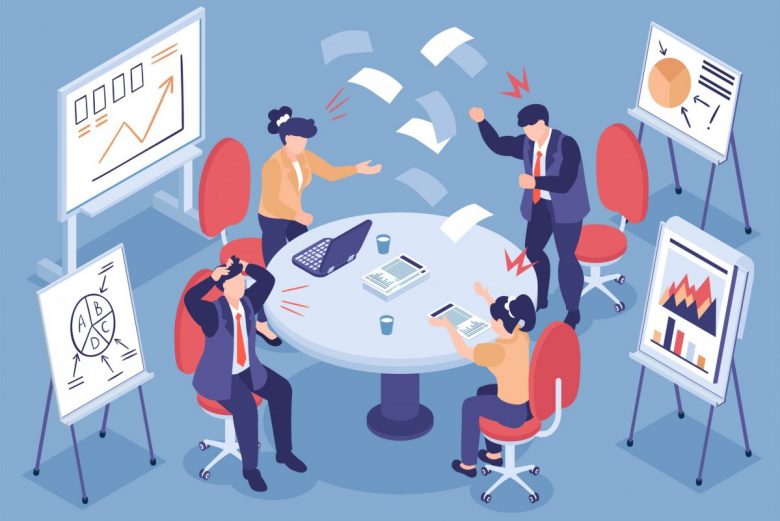People have different personalities, work styles, and backgrounds. They also have different temperaments and goals. All of this and you’re bound to have a few employees that don’t get along. Sometimes, it is bad enough that the team feels as though they are driving each other crazy.
Sure, workplace conflict is not uncommon. However, when left unresolved, these conflicts can negatively impact team morale, productivity, and overall office harmony. As a leader, understanding how to address and mitigate these issues is crucial to maintaining a cohesive work environment.
This article will look at some things leaders can do with chronic conflicts in the workplace.
Immediate Intervention
If you’re a wise leader who cares about preventing issues, you’ll step in at the first sign of conflict. The mistake many supervisors make is they wait too long when there are stressors and conflict among the team. But when they do this, by the time they step in to intervene, the issues have escalated.
On top of that, avoiding or delaying addressing a visible conflict can send the wrong message to the rest of the team. It makes it seem like management is indifferent to employee disputes. Leaders give off the “I don’t care” or “let them handle it” message.
Even worse, by not stepping in, some team members can begin to think that leaders not only tolerate the behavior but endorse it. That is why stepping in immediately is so important. Swift intervention signals that the organization values a peaceful workplace. Even if the complete resolution takes time, acknowledging the situation promptly is a step in the right direction.
Get Down to the Root Cause
Intervening is more than just breaking up the fight, it is getting involved in the dispute. However, it is not about taking sides but finding the root cause of the issues. Before jumping to conclusions or taking sides, it’s vital to understand the root cause of the disagreement. Not all conflicts are created equal. Some may arise from personal issues.
Meanwhile, others might be related to workload, roles, or professional disagreements. Taking a deep dive into the origins of the dispute will help decide how to resolve the issues. This often involves having one-on-one conversations with the involved parties, listening carefully to their perspectives, and identifying any underlying issues that might not be immediately apparent.

Implement a Conflict Resolution Policy
If you haven’t already, create a conflict resolution policy. This is so you can deal with conflicts systematically and fairly. This policy should outline the steps to be taken when a dispute arises, including how to report it, who will handle it and the potential consequences of disruptive behavior. Having a structured policy not only provides a framework for handling disputes but also ensures consistency in approach across different incidents.
Here are the steps for creating a solid policy:
- Define the purpose and scope of the policy: Clearly state its objectives and specify which types of conflicts it addresses and who is covered by it.
- Draft the policy: Outline the procedures to be followed when a conflict arises. That includes guidelines for reporting conflicts, the process for handling them, and the documentation that needs to be maintained.
- Ensure the policy complies with legal and ethical standards: Make sure the policy adheres to relevant laws, and regulations, and incorporates fairness and confidentiality principles.
- Communicate the policy: Make sure everyone knows about the policy and provide training sessions to educate them about recognizing and handling conflicts.
- Encourage feedback: Get everyone’s thoughts on the conflict resolution process and use this feedback for continuous improvement of the policy.
- Maintain detailed records of all conflict resolution proceedings: Make sure to note all conflicts so you can reference them later if needed.
Some conflicts can be handled quickly, for example, by engaging in team building activities for employees who don’t get along. However, others require a more involved approach. Next, let’s look at some of the ways to get more involved.
Talk to the Employees Not Involved in the Fighting
When conflicts happen, their effects often touch everyone in the team, even if indirectly. As a result, it’s equally crucial to engage with employees not directly involved in the conflict to get a holistic understanding of the situation and gauge the broader impact.
Talking to team members who aren’t directly involved in a conflict can give you some extra insight. They have the advantage of watching things unfold from the sidelines. Usually, they’re free from the emotional whirlwind that can blur our vision. That is unless one of their work friends is involved in the conflict.
If that is not the case, they pick up on subtle patterns and triggers that those caught up in the heat of the moment might miss. Their observations can be a good source for getting to the heart of the issue and shaping strategies to mend fences.
There’s another big plus to these chats: they show the rest of the team that we care about their experience in the workplace. When supervisors take the time to check in, it sends a powerful message that everyone’s peace of mind matters. It acknowledges that conflicts happen. However, it shows that the leaders are committed to not letting them spoil the work culture.
But, remember, there’s a delicate balance to strike in these conversations. We’re not there to stir the pot or create divisions. The goal is to understand and to show that we’re there to support, not to sensationalize. It’s critical to keep these talks confidential and reassure our team that their honest feedback is a tool for positive change, not office drama.
Facilitate a Discussion
When conflicts escalate to a point where the people involved find it difficult to communicate constructively, it’s time to have a mediated discussion. These types of discussions provide a structured environment where things can be aired out and solutions can be sought. Different types of conflicts could be driving everyone crazy.
Perhaps there is an issue with the sales team and the product development team. Maybe the sales team is overselling or overpromising customers’ product functionalities and the development team is on the hook to create something that they are not able to create.
In a case like that, getting everyone in the room from both departments to find out what the issues are is a good method. Perhaps the issue wasn’t malice but the sales team’s understanding of product features. Maybe the real issue is better educating the sales team on the products.
Mediators are there to guide the discussion. They need to make certain that both parties have an equal voice. They also need to prevent the meeting from becoming a venting session.
After the discussions, it’s essential to have a follow-up plan. Whether it’s another round of talks, implementing suggested solutions, or even just monitoring, the initial mediated discussion is often just the starting point.
Read: 8 Strategies for Dealing With Negative Employees
Revisit Job Roles and Responsibilities
Misunderstandings related to job roles and responsibilities are a common root of workplace conflicts. When employees are unclear about their duties or perceive overlaps in their roles with others, it can lead to friction, decreased productivity, and confusion.
Regularly revisiting and updating job descriptions is pivotal. As businesses evolve, roles often shift or expand. Sometimes, what was relevant a year ago might not be anymore. Other times, a person leaves and their responsibilities are never officially assigned to other people.
This creates extra stress and conflict because of the workload and people not knowing who is responsible for what. Supervisors need to go back and ensure that job descriptions accurately reflect current responsibilities. Just doing this can eliminate some potential for conflict.
Separate Team Members, If Needed
Sometimes working styles are so different that two or more people working together creates an extreme amount of tension. This tension often leads to frustration as one person prefers to work in a particular way while another opts for a conflicting way or method. If both working styles are within the guidelines of the company, this can cause conflicts.
We all would like to believe that grown adults can accommodate each other for 8 hours a day to get a job done but sometimes that is not the case. Especially, as I mentioned before, if the conflict has already become personal.
This is when leaders may need to make a decision to separate the employees involved. This could mean moving someone to another department or changing the working hours. If you are a leader that has different teams that you manage you can change the teams around to see if the dynamics change. As long as the change does not dramatically affect business operations, this may be a simple and quick option for fostering more peace in the workplace.
Monitoring Post-Conflict
Addressing a conflict is only half the battle. Relaxing too quickly after a resolution has been established can lead to the issue coming up again without warning. Leaders need to make sure that their resolution has a lasting effect. To do this, leaders need to monitor the situation closely for some time after the events and resolution attempts. I say attempts because even though you implement a resolution doesn’t mean that one will work immediately.
Regular and discreet check-ins with the people involved can provide insights into how they’re adjusting. Have there been any more arguments? Have other, non-involved, team members seen a change in the behaviors of those involved? Are they collaborating efficiently? Have the levels of casual interactions, like coffee breaks or casual chats, normalized? Have the employees involved stopped complaining about each other?
Keep in mind, these check-ins shouldn’t feel like surveillance. Instead, leaders should make team members feel like it is a chance for them to communicate any lingering concerns or share feedback on the resolution process.
Conclusion
When two or more employees don’t get along for a while it is a problem. However, when there are constant conflicts, employee gossiping, and tension, leaders need to do something quickly. Take these steps and apply them so you can begin the journey towards a more conflict-free workplace.
Also read:
8 Strategies for Dealing With Negative Employees
How to Communicate With Difficult Employees
What to Do When Employees Don’t Get Along












Pingback: How Stop Employees from Driving Each Other Crazy – Entrepreneur – Start, Run and Grow Your Business
Pingback: How Stop Employees from Driving Each Other Crazy – Austin Rotter
Pingback: How Stop Employees from Driving Each Other Crazy – Joseph Odierno Buffalo
Pingback: How to Stop Employees from Complaining About Each Other - StartUp Mindset
Pingback: What to Do When Employees Don’t Get Along - StartUp Mindset
Pingback: How to Communicate With Difficult Employees - StartUp Mindset